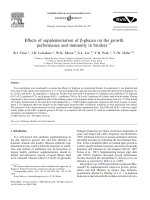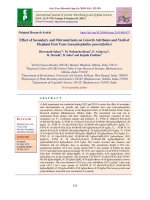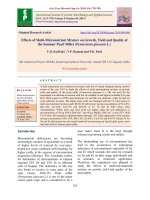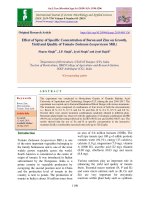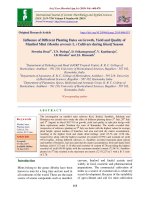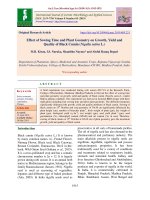Use of lemongrass (Cymbopogon citratus) leaf meal as a natural feed additive on growth performance and economics of broilers
Bạn đang xem bản rút gọn của tài liệu. Xem và tải ngay bản đầy đủ của tài liệu tại đây (208.01 KB, 8 trang )
Int.J.Curr.Microbiol.App.Sci (2019) 8(10): 1842-1849
International Journal of Current Microbiology and Applied Sciences
ISSN: 2319-7706 Volume 8 Number 10 (2019)
Journal homepage:
Original Research Article
/>
Use of Lemongrass (Cymbopogon citratus) Leaf Meal as a Natural Feed
Additive on Growth Performance and Economics of Broilers
A. K. Parade, B. M. Thombre, R. A. Patil, P. V. Padghan,
B. S. Gaikwad and P. B. Meshram*
Department of Animal Husbandry and Dairy Science, College of Agriculture, Latur, India
*Corresponding author
ABSTRACT
Keywords
Growth
performance, Feed
intake, Feed
conversion ratio,
Economics
Article Info
Accepted:
15 September 2019
Available Online:
10 October 2019
A total of eighty, day old, broiler chicks (Vencobb-430) divided in four treatments of 20
chicks in each treatment with four replication of 5 chicks. The control (T 1) group was fed
standard broiler ration and T 2, T3 and T4 group were provided same standard ration
supplemented with 0.5 per cent, 1.00 per cent and 1.5 per cent lemongrass leaf meal,
respectively. At the end of 6th week average cumulative body weight (g) in T 1, T2, T3 and
T4 were 2473.25, 2632.50, 2548.95 and 2635.45 g per birds, respectively. The average
cumulative body weight of broiler birds in the treatment groups T 4 was significantly
(P<0.05) higher as compared to those in T 1, T2 and T3 group. The total body weight gain at
the end of sixth week is 2426.28, 2585.10, 2501.53 and 2588.23 g per bird in treatments
T1, T2, T3 and T4, respectively. The chicks in treatment groups T 2, T3 and T4 grew
significantly (P<0.05) faster than T 1 control group. The total feed consumption at the end
of sixth week was 4715.28, 4540.39, 4448.66 and 4400.63 g per bird in treatments T 1, T2,
T3 and T4, respectively. Control group T 1 consume significantly (P<0.05) more feed as
compare to T4, T2 and T3 group. Feed conversion ratio from first to sixth week ranged from
1.95 to 1.70 which was significantly (P<0.05) better in T 4 (1.70) as compare to T 2 (1.75),
T3 (1.78) and T1 (1.95) control group. The results from the present study, it could be
suggested that the use of LGLM as a feed additive at the level of 1.5 per cent as it proved
be significantly better growth performance, feed intake and FCR and increase in cost of
broiler production.
Introduction
Indian poultry industry opportunities are
unlimited because India has population of
approximately 1.25 billion peoples with GDP
growth rate about 9 per cent which is one of
the biggest consumer markets in world.
Poultry contribute about 15 per cent of total
food energy and 5 per cent of dietary protein.
Poultry is major source of meat in India. Its
share in total meat consumption is 28 percent,
as against 14 percent 10 to 28 years ago. It has
outpaced its two competitors-beef or veal and
buffalo meat. High mutton prices, religious
restrictions on beef, pork and the limited
availability of fish outside coastal region have
1842
Int.J.Curr.Microbiol.App.Sci (2019) 8(10): 1842-1849
all helped to make poultry meat the most
preferred and most consumed meat in India
(Mehta and Nambiar, 2008) Nowadays,
increasing of consumer awareness for safety
poultry products and from stable to table
approach tended the consumer’s preferences
towards healthy animal products. One of the
feed additives used to increase the
performance of poultry are herbs.
Lemongrass is an aromatic perennial tropical
plant that can grow as high as 3.5 meters with
long thin leaves. Lemon grass was originally
found growing wild in India. It produces a
network of roots and rootless that rapidly
exhausts the soil. In human medicine,
Lemongrass has the following therapeutic
properties:
analgesic,
antidepressant,
antimicrobial,
antipyretic,
antiseptic,
bactericidal, diuretic, fungicidal, insecticidal
and nervous system sedative tonic (Mmereole
2010). Lemongrass (Cymbopogon citratus)
contains flavonoids, phenolic compounds,
terpenoids and essential oils (such as citral α,
citral β, nerol geraniol, citronellal, terpinolene,
geranyl acetate, myrecene and terpinol
methylheptenone) which may be responsible
for its different biological activities such as
anti-bacterial, anti-diarrheal, anti-fungal antioxidants, and as a growth promoter
(Sariozkhan et al., 2016). Chemical
composition and anti-bacterial activity of
aqueous extract of Cymbopogon citratus
leaves were studied. Moisture, Crude protein,
Crude fiber and Carbohydrate contents were
12.36%, 15.68%, 27.72% and 29.58%
respectively. Phosphorus was found to be the
most abundant (15.58mg/100g) followed by
Potassium (8.60mg/100g). Zinc an important
microelement was present in considerable
amount (0.93mg/100g) (Oloyede 2009). The
herbal growth promoters for poultry can create
optimum condition for normal vigorous
growth by acting various ways.The successful
use of herbal growth promoter will fetch more
profit to poultry farmer by efficient conversion
of feed consumed to body constituents. Lemon
grass leaf meal may also improve feed
conversion ratio and so help reduce feed costs
in broiler production especially as it is quite
inexpensive and it is abundantly available
(Mmereole 2010).
Materials and Methods
Eighty, day old, commercial straight run
broiler chicks of ‘vencobb 430’ strain were
obtained from Huma hatcheries, Latur
(Maharashtra). All the experimental chicks
were individually weighed, wing banded and
then randomly distributed in to four treatments
of 20 chicks with four replication of 5 chicks
in each treatment on similar body weight
basis.
The dietary treatments T1- 100 parts of
standard broiler ration without supplement
(control sample), T2- 99.5 parts of standard
broiler ration + 0.5 lemongrass leaf meal, T399.00 parts of standard broiler ration + 1.00
parts of lemongrass leaf meal and T4- 98.5
part standard broiler ration +1.5 parts of
lemongrass leaf meal.
All the broiler chicks were fed with ground
maize first two days of age. Chicks feed
standard feed purchased from market for three
periods of 2-10 days birds fed with pre-starter,
11-21 days birds fed with broiler starter and
22-42 days birds fed with broiler finisher. The
diets were fed ad-libitum to experimental
groups by adding required amount of
lemongrass leaf meal as per treatment. The per
cent ingredient composition of experimental
broiler ration that is for pre-starter, starter and
finisher in Table 1.
Chemical analysis
The chemical analysis of the experimental
broiler ration was carried out as per A.O.A.C.
(1995) for all the proximate principles.
1843
Int.J.Curr.Microbiol.App.Sci (2019) 8(10): 1842-1849
Statistical analysis
The treatment wise data on cumulative body
weight gain in body weight, feed consumption
and feed conversion ratio, water intake and
blood serum constituents were subjected to
analysis of variance of complete randomized
design (Snedecor and Cochran,1982).
Results and Discussion
Growth performance
The mean average cumulative body weight of
broilers in the treatment groups T4 was
significantly (P<0.05) higher as compared to
those in T1, T2, were as at par with T4 group. It
could be seen that highest cumulative body
weight of 2635.45 g obtained in T4 group
broiler receiving 1.5 per cent lemongrass leaf
meal followed by 2632.50 g with 0.5 per cent
in T2 and 2548.95 g with 1 per cent in T3 and
lowest cumulative body weight i.e. 2473.25 g
in T1 control at the end of 6th week.
The results of the present study ware similar
with Mmereole (2010) who observed that
inclusion of Cymbopogon citratus leaf meal in
poultry diet resulted in a significantly
(P<0.05) higher body weight and body weight
gain when compared to the control diet.
Similar trend was also observed by Tiwari et
al., (2018) who found that total weight gain of
birds was higher in experimental birds
receiving lemongrass oil as compared to
control group without lemongrass oil. Results
in body weight gain are given in broiler birds
under four different treatments during each
week revealed significant (P<0.05) difference
during all the weeks. At the end of sixth week
it was seen from the Table 2
that the total gain in body weight of bird amon
g treatment groups T4 and T2 was significantly
superior (P<0.05) as compared to T1 control
group and T3 group. Average gain in body
weight in T4 did differed significantly with T2
group. The treatment T1 control (2426.28 g)
was significantly lower as compared to all the
treatments i.e. T2 (2585.10 g), T3 (2501.53 g)
and T4 (2588.23 g). Whereas at par with T3
(2501.53 g)
The results obtained in the study corresponds
with the results of Mmereole (2010) who
observed that inclusion of Cymbopogon
citratus leaf meal in poultry diets resulted in
significantly (P<0.05) higher body weight and
body weight gain as compared to control diet.
Tiwari et al., (2018) also observed similar
trend and higher body weight gain where
lemongrass oil was included 400 ml/ 100 kg
feed compared to the control group. Takeli et
al., (2011) also noted that chicks fed on diet
with
supplemented
LGO
recorded
significantly heavy weight gain. These results
are in agreement with Takeli et al., (2011) and
Mukhtar et al., (2012) where their experiment
revealed significantly improve in body weight
gain for broilers fed diets supplemented with
various levels of LGO as compared with the
control group. Khattak et al., (2014) reported
that the inclusion of lemongrass leaf meal in
the broilers diet improves the body weight
gain with positive effects on feed conversion
ratio.
Feed intake
It could be seen that lowest feed consumption
of 4400.63 g was obtained in T4 group broilers
receiving 1.5 per cent lemongrass leaf meal
followed by 4448.66 g T3, 4540.39 g T2 and
the highest feed consumption i.e. 4715.28 g in
T1 at the end of 6th week. It showed that the
birds fed with lowest level of lemongrass leaf
meal and highest feed consumption rate in the
broiler birds. It was concluded from Table 3
that there were no significant differences
among the all treatment groups except third
and fourth week where as significant
differences were recorded for total feed
consumption towards end of experiment. The
1844
Int.J.Curr.Microbiol.App.Sci (2019) 8(10): 1842-1849
lemongrass leaf meals are generally tangy
taste without the bitterness of lemon,
therefore, the inclusion of LGLM in the diets
could have resulted in reduced palatability and
does reduced feed intake of the broiler diets.
The present studies are contrary to findings of
Tiwari et al., (2018) reported that lemongrass
leaf meal supplementation in broiler chicken
significantly increased feed consumption.
Takeli et al., (2011) who revealed that chicks
fed on diet with antibiotic and those
supplemented
with
LGO
recorded
significantly heavy weight gain, this improve
may be attributed to the increase in total feed
consumption.
The similar results were found by Mukhtar et
al., (2012) who reported that broilers fed diets
supplemented with various levels of LGO
consumed significantly more amount of feed
compared to the broilers fed control NC diet.
Chioma et al., (2017) reported that the
contrary results on performance parameters of
feed intake are significant (P<0.05) from the
control diet but no significance different
among the treatments (P<0.05). It can
therefore conclude that Cymbopogon citratus
are effective as toxin binder in poultry feed
without any negative implication on both
internal and external characteristics of birds.
Mukhtar et al., (2012) resulted that the
addition of LGO significantly improved
(P<0.05) feed intake of broiler chicks as
compared to the control group while non
significant (P>0.05) differences were noted
among broilers fed on diets supplemented with
LGO and antibiotic supplemented groups,
respectively.
Feed conversion ratio
The average feed conversion ratio from first to
sixth week ranged from 1.95 to 1.70 which
was significantly (P<0.05) better feed
conversion ratio of 1.70 obtained in T4 group
broilers receiving 1.5 per cent lemongrass leaf
meal followed by 1.75 with 0.5 per cent in T2,
1.78 in T3 group receiving 1.0 per cent
lemongrass leaf meal and poor in feed
conversion i. e. 1.95 in T1 control at the end of
6th week. It shows that 1.5 per cent level of
lemongrass leaf meal give better feed
conversion ratio in broiler birds.
Chioma et al., (2017) who reported that the
performance parameters of feed conversion
ratio are significant (P<0.05) from the control
diet but no significant difference among the
treatment (P<0.05). The result of present study
support the findings of similarly Mukhtar et
al., (2012) reported that supplementation of
0.5%, 1% and 1.5% LG oil is significantly
improve in feed conversion ratio for broilers
fed diets supplemented with various levels of
LGO as compared with control group.
The present results obtained are contrary to
the finding of Sariozkan et al., (2016) who
reported the feed conversion ratio were not
affected by lemongrass supplementation, In
3% supplemented group, ratio decreased
(P<0.05) (Table 4).
Thayalini et al., (2011) also reported that
supplementation of 2% LG leaf to diet did not
affect the feed conversion ratio in broilers.
Similarly, supplementation of 1.5% and 3%
LG leaf did not affect the feed conversion
ratio of quail; whereas Mmereole (2010)
reported that 1% LG leaf supplementation to
broiler diet improved the feed conversion
ratio.
Economics of broiler production
Results of economical analysis of including
lemongrass leaf meal in broilers diets are
presented in Table 5. The economical values
were calculated according to prevailing local
market (selling) prices at the experimental
time (2019).
1845
Int.J.Curr.Microbiol.App.Sci (2019) 8(10): 1842-1849
Table.1 Chemical composition of experimental broiler ration
Sr.
No.
1
2
3
4
5
6
7
8
Per cent in ration
Pre-starter
Starter
Finisher
23.35
21.64
20.20
3.92
3.96
3.99
4.95
5.08
5.12
6.2
6.1
5.93
1.57
1.60
1.62
61.58
63.22
64.76
2982.5
3065.7
3198.8
127.73:1
141.66:1
158.35:1
Nutrients
Crude protein
Crude fibre
Ether extract
Total ash
Acid insoluble ash
Nitrogen free extract
Metabolizable energy (kcal/kg)
E/P ratio
Table.2 Body weight gain of broiler chicks as affected by addition of lemongrass leaf meal
Items
st
1 week
2nd week
3rd week
4th week
5th week
6th week
Total
T1 (0%)
119.03
196.00
320.25a
532.25
609.78
648.98
2426.28 a
LGLM level
T2 (0.5%)
T3 (1%)
123.39
102.08
211.22
199.50
b
436.49
450.67b
515.00
485.33
611.00
590.65
688.00
673.30
a
2585.10
2501.53ab
T4 (1.5%)
SE
150.61
14.75
217.42
22.96
b
468.74
23.93
487.73
18.15
606.68
20.48
657.05
25.09
b
2588.23
33.72
CD at 5%
NS
NS
*
NS
NS
NS
*
(Significant (P<0.05) means under each class in the same column with different superscripts differ significantly)
Table.3 Feed intake of broiler chicks as affected by addition of lemongrass leaf meal
Items
LGLM levels
T1
T2
1 week
2nd week
3rd week
(0%)
138.76
341.04
726.82b
4th week
1135.72b
5th week
1117.17
1140.71
1092.70
1255.77
4715.28b
1244.70
4540.39ab
1209.20
4448.66ab
st
th
6 week
Total
(0.5%)
124.75
307.70
622.98a
T3
1099.56b
(1%)
141.30
297.35
648.50a
1059.73ab
T4
(1.5%)
156.41
320.06
651.67 a
1013.17a
23.70
*
1102.68
23.29
NS
1156.64
4400.63 a
32.38
59.22
NS
*
(Value superscripted differently, differs significantly (P<0.05) within a column)
1846
SE
CD at 5%
8.36
NS
20.59
NS
17.74
*
Int.J.Curr.Microbiol.App.Sci (2019) 8(10): 1842-1849
Table.4 Effect of dietary lemongrass leaf meal on feed conversion ratio of broiler chicks
Items
1st week
2nd week
3rd week
4th week
5th week
6th week
Total
T1
(0%)
1.17
1.74
2.27 b
2.14
1.83
1.96
1.95b
T2
(0.5%)
1.01
1.45
1.42a
2.13
1.86
1.80
1.75a
LGLM levels
T3
T4
(1%)
(1.5%)
1.38
1.04
1.49
1.47
a
1.44
1.39a
2.18
2.07
1.85
1.81
1.79
1.76
1.78a
1.70a
SE
0.03
0.09
0.03
0.04
0.02
0.05
0.03
CD at 5%
NS
NS
*
NS
NS
NS
*
NS = no significant difference (P>0.05) *Significant difference (P<0.05)
Table.5 Economics of broiler production per bird
Particular
LGLM levels
T1
T2
T3
T4
(0%)
(0.5%)
(1%)
(1.5%)
45
45
45
45
0
15.35
22.24
33.00
0
0.28
0.28
0.28
0
3.18
6.23
9.24
4715.28
4540.39
4448.78
4400.63
28.9
28.9
28.9
28.9
136.27
134.21
128.56
127.18
136.27
137.39
134.79
136.42
2426.28
2585.10
2501.53
2588.23
Cost of day old chicks (Rs.)
Lemongrass consumed per bird (g)
Cost of Lemongrass (₹ /g)
Cost of Lemongrass (Rs.)
Avg. Total feed consumed per bird (g)
Cost of feed (₹ /Kg)
Cost of feed consumed per bird
Total cost of feed consumed per bird ₹
Avg. Body weight gain at the end of
6th week (g)
Feed consumption per kg live weight (g) 1943.42
Cost of feed per kg live weight gain (₹ ) 56.16
Cost of medicine, vaccine and litter
6
material per bird (₹ )
Cost of Production per bird (₹ )
187.27
Avg. Price realized @ ₹ 90 Per kg live
224.74
weight (₹ )
Net profit per bird (14-13) ₹
37.47
1756.37
50.68
6
1778.42
51.40
6
188.39
232.66
185.39
225.14
43.61
39.35
1700.25
49.14
6
187.43
232.94
45.52
(Similar superscript do not differ significantly (P<0.05) from each other within a row the quantity of feed additive
LLM increased.)
1847
Int.J.Curr.Microbiol.App.Sci (2019) 8(10): 1842-1849
The data regarding average live body weight
(g), average feed consumption (g), feed
consumption per kg live weight gain, cost of
feed (Rs.), total cost of feed (including cost of
lemongrass used per kg of feed under different
treatments), cost of feed per kg live weight
gain and net profit per bird are given in Table
5. The observation from the following table
was indicated that the performance of broilers
in T4 group was superior to that of the control
and other treatments and 1.5 per cent level of
lemongrass leaf meal in broiler diet seems to
be economical. This might be due to improved
feed conversion efficiency on supplementation
of lemongrass leaf meal and also due to rich
nutrient content of lemongrass. These results
were partially in agreement with Mukhtar et
al., (2012) results of economical evaluation
showed that the addition of dietary LGO
improved the performance of broiler chicks
and resulted in economical benefits compared
to control and antibiotic groups.
The results of economical evaluations of the
experimental diets showed that the
supplementation of lemongrass leaf meal to
broiler diets improved the performance of
chicks and resulted economic benefits. The
ratio of broilers fed with 1.5 % LGLM was the
highest although all chicks fed on different
levels recorded high ratio of profits compared
to control group these result were in
agreement with findings of Mukhtar et
al., (2012). Economically the addition of LGO
improved the performance of broiler chicks
and resulted in economic benefits Tiwari et
al., (2018).
This study indicated that supplementation of
lemongrass leaf meal powder at the difference
levels of 0.5 %, 1.0 % and 1.5 % in the broiler
chick’s diet. Inclusion of 1.5% lemongrass
leaf meal powder in broiler ration was
beneficial in improving live weight and weight
gain and 1.5 percent LGLM in broiler diet
improved FCR. The inclusion of 1.5 per cent
of lemongrass leaf meal in broiler diet as a
herbal feed supplement is economical. The
feeding of lemongrass leaf meal is economical
as it improved overall performance of broilers
and increased margin of profit in broiler
production. Addition of 1.5 per cent
lemongrass leaf meal powder is economical.
References
A. O. A. C. 1995. Official Methods of
Analysis, 16th ed. Association of
Official
Analytical
Chemist,
Washington D. C.
Chioma G. O., Akinsoyinu O. A., Olumide M.
D., Ajayi O. A., Ndubuisi-Ogbonna L.
C., Akinboye O. E., Adeyeye J. A.,
AyoBello T. and Afodu O. J. 2017.
Carcass
and
Performance
Characteristics of Broiler Chickens
Fed with Cymbopogon citratus Leaf
Meal as Alternative to Mycotoxin
binder. International J. of Agril. Sci.
6(4):018-023.
Khattak F., Ronchi A., Castelli P. and Sparks
N. 2014. Effects of Natural Blend of
Essential Oil on Growth Performance,
Blood
Biochemistry,
Cecal
Morphology and Carcass Quality of
Broiler Chickens. J. of Poult. Sci.
93(6):132-137
Mehta R. and Nambiar R. G. 2008. The
Poultry Industry in India. Poultry in
the 21th Century. 1-61.
Mmereole F. U. C. 2010. Effects of Lemmon
Grass (Cymbopogon citratus) Leaf
Meal Feed Supplement on Growth
Performance of Broiler Chicks.
International J. of Poult. Sci.
9(12):1107-1111.
Mukhtar A. M., Mohamed K. A., Amal O. A.
and Ahlam A. H. 2012. Effect of
Different Levels of Lemon Grass Oil
(LGO) as a Natural Growth Promoter
on the Performance, Carcass Yield and
Serum
1848
Int.J.Curr.Microbiol.App.Sci (2019) 8(10): 1842-1849
Chemistry of Broiler Chicks. Egypt
Poult. Sci. 33(1): 1-7.
Oloyede O. I., 2009. Chemical Profile and
Antimicrobial
Activity
of
Cymbopogon citrates Leaves. J. of
Natural Products. 2(23): 98-103.
Sariozkan S., Konca Y., Kocaoglu B., Aktug
M. K., Ozkan S. and Tugrul S. 2016.
The Effect of Dietary Supplementation
of Lemon Grass (Cymbopogon
Citratus) on Performance, Carcass
Quality, and Marketing of Quail
(Coturnix Coturnix Japonica). J.
Scientific Works. Series C. Veterinary
Med. 63(1): 98-103.
Snedecor G. W. and Cochram W. G. 1982.
Statistical Methods. 6th Edition,
Oxford and IBH Publishing co.
Culcutta, Bombay and Delhi. Pp. 168181.
Takeli A. Kutlu H. R. And Celik l. 2011.
Effect of Zingiber officinalis and
Propolis Extract on the Performance,
Carcase and Some Blood Parameters
of Broiler Chicks. Current Res. in
Poult. Sci. 1(1): 12-33.
Thayalani K., Shanmugavelu S., Saminathan
P. M., Masidayu M. S., Nor I. Y.,
Zainuddin H., Nural A. C. and Wong
H. K. 2011. Effect of Cymbopogan
citrates Leaf and Zingiber officinale
Rhizome Supplementation on Growth
Performance, Ideal Morphology Lactic
Acid Concentration in Broiler. Mal. J.
Anim. Sci. 14(8): 43-49.
Tiwari M. R., Jha P. K., Sah B., Kunwar G.
and Jha A. K. 2018. Performance of
Lemongrass (Cymbopogon citrates)
Oil as Growth Promoter in Broiler.
Bang. J. Anim. Sci., 47(2): 85-91.
How to cite this article:
Parade, A. K., B. M. Thombre, R. A. Patil, P. V. Padghan, B. S. Gaikwad and Meshram, P. B.
2019. Use of Lemongrass (Cymbopogon citratus) Leaf Meal as a Natural Feed Additive on
Growth Performance and Economics of Broilers. Int.J.Curr.Microbiol.App.Sci. 8(10): 18421849. doi: />
1849

